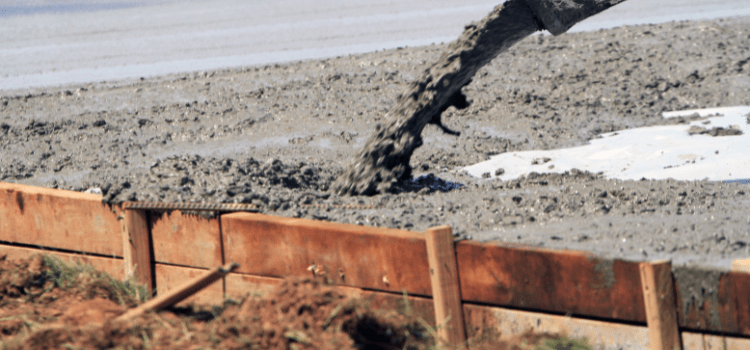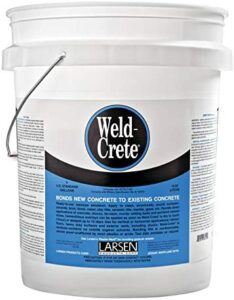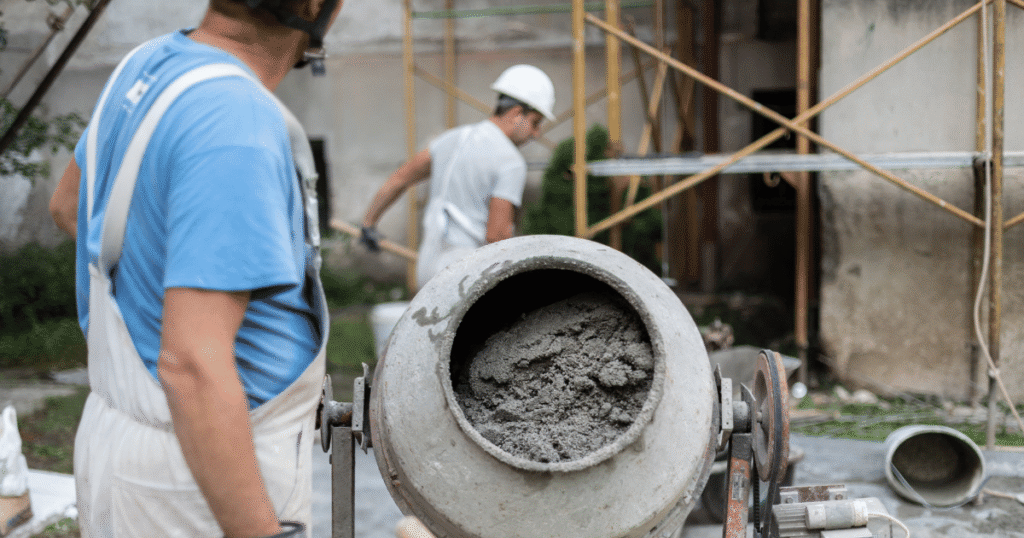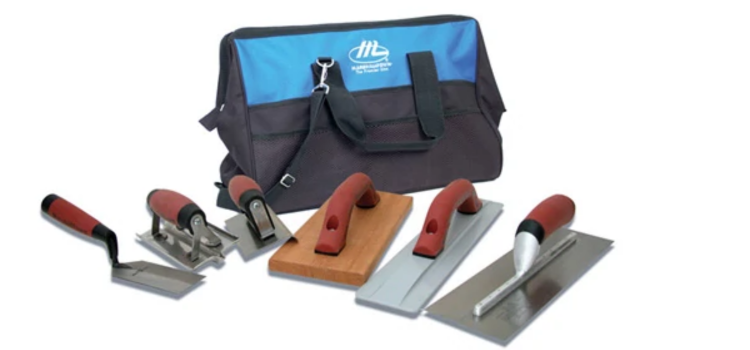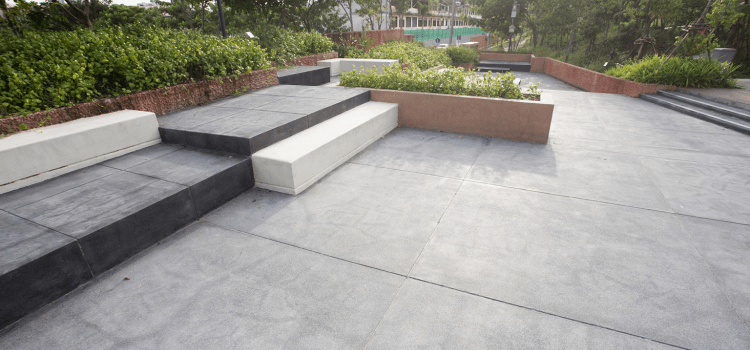There are many benefits to pouring concrete over old concrete but it’s important to take certain steps to ensure a successful outcome.
In some cases, it may be better to remove the old concrete and start fresh, this can be more expensive, but it ensures a strong and durable surface that will last for years to come.
Here are some things to keep in mind when pouring concrete over old concrete.

Should You Be Pouring Concrete Over Old Concrete?
Whether you should pour concrete over concrete depends on several factors, including the condition of the existing concrete, the purpose of the new concrete, and your budget.
If the existing concrete is in good condition, with no major cracks or other damage, pouring new concrete over it can be a good option.
This can be a cost-effective way to create a new surface, such as a driveway or patio, without having to remove and replace the old concrete.
However, if the existing concrete is in poor condition, with significant cracks or other damage, pouring new concrete over it may not be a good idea.
The new concrete may not adhere properly to the old concrete, leading to a weaker and less durable surface.
Ultimately, the decision to pour concrete over concrete depends on the specific circumstances. It’s always a good idea to consult with a professional contractor who can assess the condition of the existing concrete and recommend the best course of action.
Steps To Pouring Concrete Over Old Concrete
1 – Clean The Existing Concrete:
Clean the existing concrete: Before pouring new concrete, make sure the old concrete is clean and free of debris. Use a pressure washer or scrub brush to remove any dirt, dust, or loose material. You can also use a concrete degreaser to remove any oil or grease stains.
2 – Rough up the surface:
It’s important to create a rough surface on the old concrete to help the new concrete bond properly. You can do this by using a concrete grinder, shot blaster, or hammer drill with chisel bit to rough up the surface.
3 – Apply a bonding agent:
A bonding agent can help the new concrete adhere to the old concrete. Apply a thin layer of bonding agent to the old concrete before pouring the new concrete.
4 – Add reinforcement:
Adding reinforcement to the new concrete can help strengthen the overall structure. You can use rebar or wire mesh to reinforce the new concrete.
5 – Pour the new concrete:
Once you’ve prepared the old concrete, it’s time to pour the new concrete. Make sure the new concrete is at least 2 inches thick to ensure a strong and durable surface.
6 – Allow the concrete to cure:
After pouring the new concrete, it’s important to allow it to cure properly. This can take several days or even weeks, depending on the weather and other factors.
Do You Need To Use A Concrete Bonding Agent?
Using a concrete bonding agent is recommended when pouring new concrete over existing concrete.
A bonding agent can improve the adhesion between the old and new concrete surfaces, resulting in a stronger and more durable surface
Without a bonding agent, the new concrete may not properly adhere to the old concrete, which can lead to cracking and other problems over time.
When using a bonding agent, be sure to follow the manufacturer’s instructions for application and curing times. Generally, you will need to apply a thin layer of bonding agent to the old concrete surface before pouring the new concrete.
Using a bonding agent is especially important if you’re pouring new concrete over a smooth or polished surface, as these surfaces can be difficult for the new concrete to adhere to. In addition, a bonding agent can help prevent moisture from seeping into the concrete, which can cause damage over time.
How Thick Should A Concrete Overlay Be?
The thickness of a concrete topping layer can vary depending on the specific application and the condition of the existing concrete surface.
In general, a minimum thickness of 2 inches (5 cm) is recommended for a concrete topping layer.
If the existing concrete surface is in good condition, a 2-inch topping layer can be sufficient for most applications, including driveways, patios, and sidewalks. However, if the existing surface is damaged or uneven, a thicker topping layer may be needed to provide a level and smooth surface.
For commercial or industrial applications, where the concrete surface will be subjected to heavy loads or frequent use, a thicker topping layer may be required. In some cases, a thickness of 3-4 inches (7.5-10 cm) or more may be needed to provide adequate strength and durability.
It’s always a good idea to consult with a professional concrete contractor who can assess the condition of the existing surface and recommend the appropriate thickness for the topping layer based on the specific application and usage requirements.
Is Pouring Concrete Over Old Concrete Expensive?
Pouring concrete over old concrete can be a cost-effective option in some cases, as it can save you the cost and effort of removing the old concrete and starting from scratch. However, the cost of pouring concrete over old concrete can vary depending on several factors, including:
1 – The condition of the existing concrete:
If the existing concrete is in good condition and requires minimal preparation, pouring new concrete over it can be a relatively inexpensive option. However, if the existing concrete is damaged, cracked, or requires significant repairs, the cost of preparing the surface and pouring new concrete can be higher.
2 – The thickness of the new concrete:
The thickness of the new concrete will affect the cost, as thicker layers require more materials and labor to install.
3 -The size of the area:
The larger the area to be covered, the more materials and labor will be required, which can increase the cost.
4 – The complexity of the job:
If the job requires additional preparation, such as installing reinforcing materials or applying a bonding agent, the cost may be higher.
Overall, the cost of pouring concrete over old concrete can range from relatively inexpensive to more expensive, depending on the specific circumstances. It’s always a good idea to consult with a professional concrete contractor who can assess the condition of the existing concrete and provide an estimate for the cost of pouring new concrete over it.
Pros And Cons To Pouring Concrete Over Old Concrete

There are different opinions and considerations when it comes to pouring concrete over concrete. Here are some arguments for and against this practice:
Arguments in favor of pouring concrete over concrete:
- Cost-effective: Pouring concrete over existing concrete can be a cost-effective way to create a new surface without having to remove and dispose of the old concrete.
- Time-saving: Pouring concrete over existing concrete can save time compared to removing and replacing old concrete, as it eliminates the need for demolition and disposal.
- Sustainability: Reusing the existing concrete by pouring new concrete over it can be a more sustainable option, as it reduces waste and conserves resources.
Arguments against pouring concrete over concrete:
- Adhesion: Pouring new concrete over old concrete can pose adhesion problems, as the new concrete may not properly bond with the old concrete surface, leading to cracking and other issues.
- Thickness: Pouring a thick layer of concrete over existing concrete can add significant weight to the structure, which may not be suitable for some applications.
- Surface preparation: Pouring concrete over existing concrete requires proper surface preparation, including cleaning, repairing, and profiling the old concrete surface, which can add time and expense to the project.
Ultimately, whether pouring concrete over concrete is a good option depends on the specific circumstances, such as the condition of the existing concrete, the intended use of the new surface, and the budget and timeline for the project.
It’s always a good idea to consult with a professional concrete contractor who can assess the situation and provide recommendations for the best course of action.
Is Pouring Concrete Over Old Concrete Recommended
Pouring old concrete over concrete depends on the underlying concrete and its foundation.
Removing old concrete foundations can become a long and sometimes expensive task, however, if the old concrete is sitting on hard foundations it may be the better solution.
So is pouring concrete over old concrete recommended? Ideally no, however, there are times when pouring concrete over old concrete is the cheaper and most viable option.


